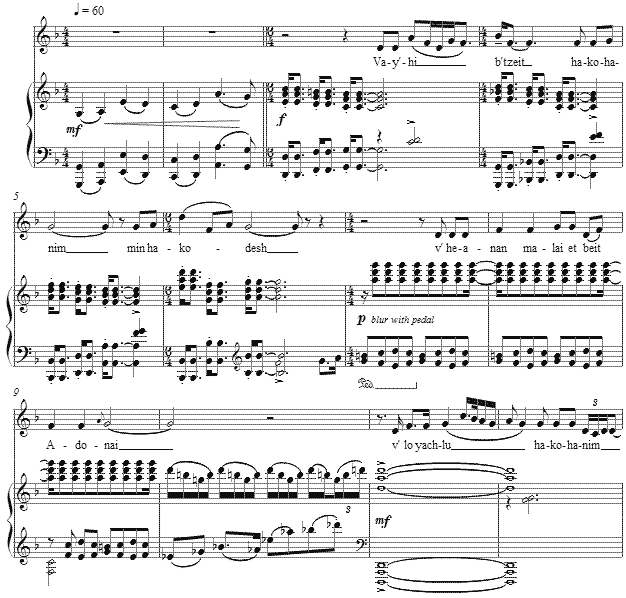Music and Texts of GARY BACHLUND
Vocal Music | Piano | Organ | Chamber Music | Orchestral | Articles and Commentary | Poems and Stories | Miscellany | FAQs
Az amar Shlomo - (1998)
Biblical text
for medium voice and piano
for my friend, William Kramer
[ 2 pages, circa 2' 15" ]
I Kings 8:
10 And it came to pass, when the priests were come out of the holy place, that the cloud filled the house of HaShem,
11 so that the priests could not stand to minister by reason of the cloud; for the glory of HaShem [ 1 ] filled the house of HaShem.
12 Then spoke Solomon: "HaShem hath said that He would dwell in the thick darkness.
13 I have surely built Thee a house of habitation, a place for Thee to dwell in for ever.
As in the Jewish Publication Society edition in English, 1917.
Rabbi William Kramer
Rabbi William Kramer (1920-2004) had a multifaceted career as rabbi, historian, author, professor, lawyer, family counselor, actor and art collector. Born in Cleveland, Rabbi Kramer earned seven college and university degrees and assumed his first pulpit in St. Louis before he was 23 years old. After coming to Los Angeles, he served at Temple Israel of Hollywood before settling down for 30 years as spiritual leader of Temple Beth Emet, also speaking at a weekly minyan at Adat Shalom. He established the Jewish studies program at California State University at Northridge, and taught at Hebrew Union College-Jewish Institute of Religion, Los Angeles City College, University of Judaism, University of Southern California and the University of California at Los Angeles. He wrote a weekly column for Heritage and contributed to a range of Jewish, legal, art and poetry journals. He was a leading chronicler and researcher of early Jewish life in the Western United States, serving as co-editor of the Western States Jewish Historical Quarterly with Dr. Norton B. Stern. His visage and white beard lent him the aspect of a biblical patriarch, and he was cast as a rabbi in various movies and television shows. A versatile scholar, Rabbi Kramer also has taught college level Archaeology and Art History. He had a Doctor of Hebrew Letters degree and an Honorary Doctor of Divinity from Hebrew Union College. He commented, “I do not think of the divisions of Judaism as divisions. I am annoyed when asked, after I have been introduced as a rabbi, ‘What kind of rabbi are you?’ I know what they want me to answer, but I answer as I want. ‘Jewish,’ I say, ‘Jewish!’” I shared the pulpit with him for many services, and sometimes during the High Holy Days, he would casually and leisurely stop mid-service and ask me to repeat some bit of nusach or a set piece from the liturgy for the inspiration he derived from it. This art song setting of a portion of scripture was suggested by him in one of our conversations.
In the manner of a set piece within the tradition of cantorial solos, the D minor accompaniment announces the vocal line which is based loosely on one of the Ashkenazic haftorah tropes, with their formulaic melismas. Rubati in performance is suggested.
The textures of the piano accompaniment move between sharply delineated attacca and such blurred polytonalities as shown below. The three-fold mystery of the text, "Kadosh, Kadosh, Kadosh" was rendered into the Latin "Sanctus, Sanctus, Sanctus" and thence into the oft heard "Holy, holy, holy" in various English language texts. A favorite explanation for this tripartite repetition, drawn from several rabbinic commentaries, suggests that behind the mystery of God lies a mystery of God which is hidden by the mystery of God. In other words, the inexplicable is conjured into an impossible-to-view image by the repetition itself. Behind the veil or mystery lies yet another, and thus may we say not so much something about God, but about ourselves. We mere mortals are incapable of penetrating even the first, and were we somehow able, we would meet yet another impenetrable mystery. Thus this "house of the Lord" is bathed in a wash of polytonal colors as the musical image.
The score for is available as a free PDF download, though any major commercial performance or recording of the work is prohibited without prior arrangement with the composer. Click on the graphic below for this piano-vocal score.
NOTES
[ 1 ] An explanation for non-Jews: The term in Hebrew as transliterated in the English syllables HaShem is in fact the compound form word for God. Often highly observant Jews spell even the word in English with a hyphen, G-d, as an expression of deep respect for the "name," for in fact HaShem is the definite article and noun for "the Name," correctly translated. In sung texts from various periods as in transliterations in prayer books, this is rendered aloud as "Adonai," which more properly corresponds with "Lord" in the non-Jewish sense. I choose to print the word, "Adonai," in the score's text after the fashion of many decades of Jewish composers and their publishers.






